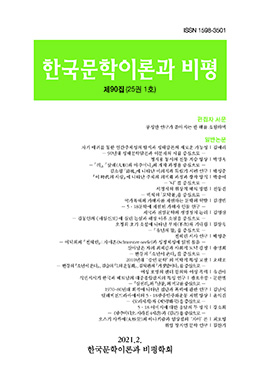본고는 선행 연구의 미진한 점을 보완하여 여러 근거를 통해, 민간신앙의 ‘업’이라는 용어가 불교 용어인 ‘업(業)’에서 비롯되었다고 하나의 기원설을 내세워 본 것이다. 이를 위해 민간신앙의 ‘업’과 불교의 ‘업(業) 사상’과의 연관성을 용어·존재(짐승)·설화 내용·성격·속성 등의 유사성으로 두루 살펴보았다.
첫째, ‘업’과 ‘업(業)’, ‘업구렁이’와 ‘업(業)구렁이’, ‘업神’과 ‘업신(業身)’이 동음이의어이다. 둘째, 민간신앙에서 전형적인 업神은 구렁이이고, 업(業) 사상에서 악업(惡業)으로 인해 전형적으로 환생하는 짐승도 구렁이이다. 셋째, 업神은 수곡신(守穀神)으로 자신이 머무는 곳간이나 쌀독의 재물을 지킨다. 악업으로 인해 환생한 구렁이도 수곡신으로 곳간이나 쌀독에서 생전의 재물을 지킨다. 넷째, 업神과 업(業)구렁이 모두 집안의 재물을 지킨다는 점에서 재물신과 수호신적 성격을 가진다. 또한 업神 신앙과 업(業) 설화가 사람들 사이에 구전됨으로써, 사람들은 업神이 업(業) 사상에 의한 조상의 환생일 수도 있다는 생각을 하게 된다. 이로 인해 업(業)구렁이는 곧 업神으로 상정(想定)되어, 업神과 업(業)구렁이 모두 조상신적 성격을 지니게 된다. 다섯째, 업神과 업(業)구렁이는 모두 귀가 돋쳐 있는 구렁이이다. 사람들은 두 존재에게 밥이나 죽을 바치고, 짚가리로 만든 신체(神體)에 모신다. 이처럼 두 존재는 속성이 유사하다.
이상의 근거들로 민간신앙의 ‘업’이란 용어의 기원은 불교 용어인 ‘업(業)’에서 파생돼 그 의미가 확장·변화되었을 것이라고 하나의 가능성을 제시해 본다.
Complementing the lack of prior research, this study claimed a theory of origin that the term ‘Eop(God)’ of folk belief originated from the Buddhism term ‘Eop(Karma)’. To this end, the association between the ‘Eop(God)’ of folk belief and the ‘Eop(Karma) thought’ of Buddhism with similarities in terms, existence(animal), tale content, personalities, attributes was examined in a wide range.
First, the ‘Eop(God)’ and the ‘Eop(Karma)’, the ‘Eop(God) big snake’ and the ‘Eop(Karma) big snake’, the ‘Eopsin(업神)’ and the ‘Eopsin(業身)’ are homonyms. Second, in folk belief, the typical the Eop god is a big snake and in the Eop(Karma) thought, the animal typically reincarnated by bad karma is also a big snake. Third, Eop god is a guardian deity, which protects the property of a storeroom or the rice jar where he stays. A big snake reincarnated by bad karma is also a guardian deity and lives in a storeroom or the rice jar to protect his wealth of a previous life. Fourth, Eop god and Eop(Karma) big snake both protect the wealth of the house, so they have a personality of property deity and guardian deity. Also, as faith of the Eop god and Eop(Karma) tale are passed down among people, people come to think that Eop god may be the reincarnation of ancestors by Eop(Karma) thought. As a result, the Eop(Karma) big snake is considered to the Eop god, and both Eop god and Eop(Karma) big snake have personality of ancestral deity. Fifth, Both Eop god and Eop(Karma) big snake are snake with ears. People offer boiled rice or porridge to both beings and enshrine them in the Sinche(神體) made of straw. As such, the two beings have similar attributes.
Based on the above grounds, I propose a possibility that the origin of the term ‘Eop(God)’ in folk belief may have been derived from the Buddhism term ‘Eop(Karma)’ and its meaning expanded or changed.




